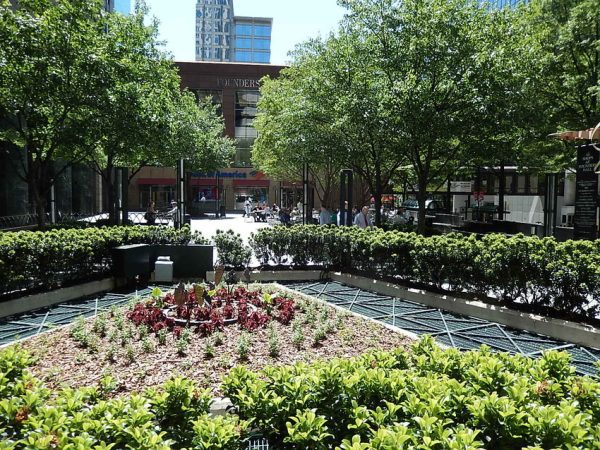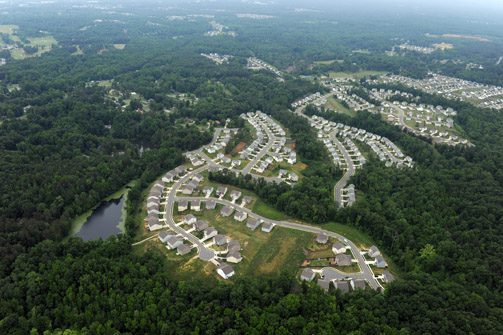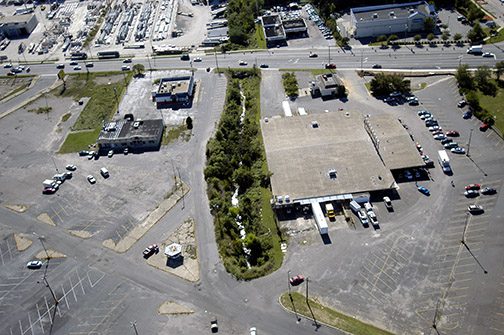Charlotte is backing off its goal of 50 percent tree canopy by 2050

Charlotte won’t reach its goal of tree canopy covering 50 percent of the city by 2050, officials said last week.
Instead, the city is planning to focus on smaller, neighborhood-level targets and “fifty-themed” initiatives to promote trees.
“It’s still possible to reach 50 percent, but it would be extremely challenging,” said city arborist Tim Porter, speaking at Charlotte City Council’s Neighborhood Development Committee meeting last week. “I’m not sure (a single metric) is the best fit for a city as complex, as large, as Charlotte. It’s very difficult to show progress.”
Charlotte is currently at just under 47 percent tree canopy coverage, according to the latest detailed measurements – basically flat since 2012.
Though the city takes pride in its leafy green canopy, there are numerous challenges facing Charlotte’s trees. Large swaths of the city’s biggest trees were planted at the same time, decades ago, when neighborhoods like Myers Park were built. They’re aging – and will eventually be dying – at the same rate, and replacing them will take years. The city now removes about 1,400 street trees annually, up from 900 a few years ago.

New subdivision construction in Charlotte. Photo: Nancy Pierce
Meanwhile, new developments continue to clear large areas, and the city’s tree-save rule only preserves a small percentage of each site’s tree area (generally 10 percent). And the fee-in-lieu payments that developers sometimes give the city to buy their way out of the tree-save ordinance go towards purchasing and preserving existing stands of trees, not creating new ones.
Chuck Cole, executive director of Trees Charlotte, said he thinks the city’s shift away from focusing on a single metric makes sense, especially as the city’s ongoing development occupies more land.
“Do I think that we’re going to get to 50 percent canopy coverage? No, I don’t,” said Cole.
Council member Justin Harlow, chair of the Neighborhood Development Committee, agreed that increasing the city’s tree canopy coverage to 50 percent isn’t realistic.
“What we’re learning is that in a city growing like Charlotte, we could never meet a 50 percent goal just by the nature of development,” Harlow told the Urban Institute. Two years ago, a consultant estimated that, based on Charlotte’s current development ordinances, tree canopy would cover about 41 percent of the city once Charlotte is fully built-out.
In Charlotte, the city’s trees provide about $335 million worth of benefits annually, according to the city. Much of that is in the form of added property value. But the benefits of a robust tree canopy in urban areas go beyond pretty greenery.
Trees provide shade and counteract the “urban heat island” effect, lowering the sweltering temperatures generated by acres of asphalt and other impermeable surfaces soaking up the sun. They soak up water and hold together soil, fighting the torrents of stormwater runoff after a big rain. Urban trees also provide wildlife habitat, filter the air and sequester carbon dioxide.
50 by 50
When Charlotte City Council adopted the “50 by 50” goal in 2011, the idea was to set an aspirational target that would keep the fast-growing city focused on trees even as development cleared more land. But in its most recent tree canopy assessment, the city found coverage is about 46.8 percent percent. That’s down slightly from 2012 – a decrease of 0.3 percent – but it’s within the survey’s 0.9 percent margin of error.
City officials aren’t sure if the tree canopy is treading water or shrinking, but admit it’s likely the latter.
“That could mean the canopy is holding strong,” Porter said of the latest coverage number. “But we’re still not exactly sure what the trend is right now. Our best guess it’s likely declining.”
Despite the changing goals, Charlotte isn’t scrapping the “50 by 50” language, however. The slogan is catchy, and easy to understand.
“We believe that 50 by 50 is a tagline that’s really connected in the community,” said Porter.
So the city will instead focus on goals that include “50,” but don’t refer to Charlotte having full 50 percent canopy coverage. Those could include measures such as:
- Replanting at least 50 percent of street trees the city cuts down each year.
- Recognizing and celebrating individual neighborhoods with 50 percent or more tree canopy.
- Holding 50 outreach and engagement events per year.
- Creating 50 “urban arboreta” to celebrate and educate people about trees.
The city is also writing a new comprehensive master plan and unified development ordinance. Planning Director Taiwo Jaiyeoba said the revised plan will include the city’s urban forestry master plan, and new development rules will encourage tree-saving in different contexts, specific to the type of place.
Changing canopy, changing measures

Development at North Tryon Street and West Sugar Creek Road. Photo: Nancy Pierce.
Charlotte’s shift away from a single metric is in line with what conservation group American Forests now recommends. In 1997, the group set a minimum standard of 40 percent tree canopy coverage as the goal for cities. But in 2017, American Forests scrapped that target, instead recommending more nuanced, place-specific goals that take local factors into account.
“While incredibly valuable and groundbreaking at the time, technology and research have significantly evolved over the past 20 years, leading to a consensus that more nuanced approaches are necessary,” the group wrote.
Even as the city considers new goals, Porter said Charlotte is also facing another issue: While small and medium plantings of trees are growing, big, multi-acre stands of trees are on the decline.
“The city is losing the larger swaths of contiguous forest,” said Porter. “Those are the biggest machines producing all the benefits.”
And it’s getting harder to find large tracts to plant on to replace those that are lost, said Cole.
“Large areas of land where we could go an have impact, plant 700 trees, just aren’t available anymore,” he said. “The space just isn’t there. It’s all chopped up.”
The committee voted to recommend the changes to Charlotte’s tree canopy goals to the full City Council, which is expected to consider the policy at a July meeting. Members indicated they were supportive.
“It’s not a one-dimensional problem, and it’s not solved by a one-dimensional metric,” said council member Ed Driggs.